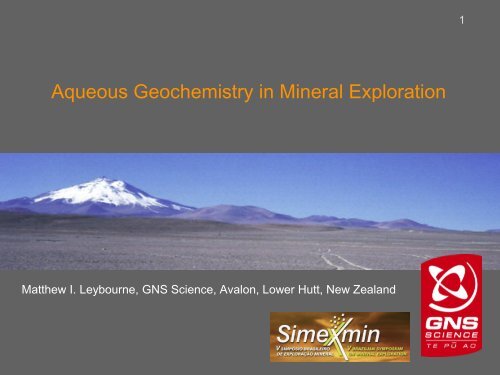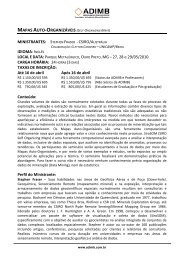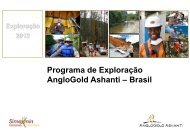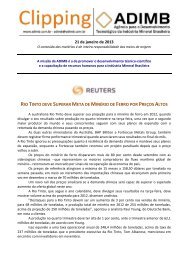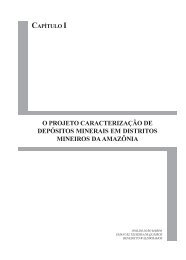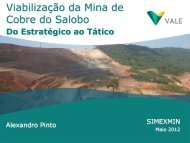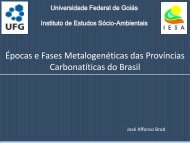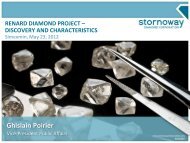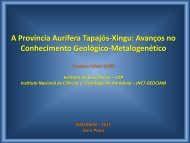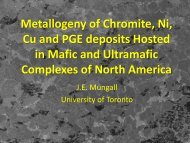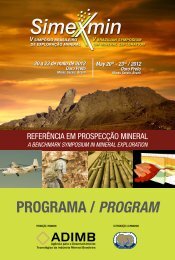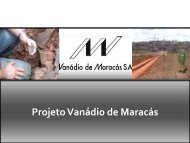Aqueous Geochemistry in Mineral Exploration - ADIMB
Aqueous Geochemistry in Mineral Exploration - ADIMB
Aqueous Geochemistry in Mineral Exploration - ADIMB
You also want an ePaper? Increase the reach of your titles
YUMPU automatically turns print PDFs into web optimized ePapers that Google loves.
1<strong>Aqueous</strong> <strong>Geochemistry</strong> <strong>in</strong> M<strong>in</strong>eral <strong>Exploration</strong>Matthew I. Leybourne, GNS Science, Avalon, Lower Hutt, New Zealand
Outl<strong>in</strong>e• Why aqueous geochemistry <strong>in</strong> m<strong>in</strong>eral exploration?• Field analyses - importance of pH and Eh• Major species• Trace metals and metalloids• Stable isotopes• Radiogenic isotopes• Insights ga<strong>in</strong>ed from water chemistry• Seawater exploration for SMSGNS Science
Utility of groundwater geochemistry• Significant challenge for m<strong>in</strong>eral exploration is to f<strong>in</strong>dnew and deeper deposits, particularly <strong>in</strong> areas whereeither thick cover exists• Where past exploration has already discovered shallowm<strong>in</strong>eralization and exploration must extend to greaterdepth• Groundwater recharges to depth, result<strong>in</strong>g <strong>in</strong> greaterlikelihood of <strong>in</strong>teract<strong>in</strong>g with buried m<strong>in</strong>eralizationcompared to surficial geochemical methods, thusprovid<strong>in</strong>g a three dimensional perspective• <strong>Aqueous</strong> geochemistry can provide <strong>in</strong>sights <strong>in</strong>to othersample media and dispersion processes, secondarym<strong>in</strong>eral formationGNS Science
Natural waters vs AMDGNS Science
Field based analyses- pH and redoxKZK (Yukon)Spence (Chile)GNS Science
Major species: Monturaqui, Salar de Punta Negraand Hamburgo Bas<strong>in</strong>GNS Science
Major species: Kirkland Lake,OntarioGNS Science
Trace metals and metalloidsGNS Science
Trace elements - Spence, ChileGNS Science
Trace elements - Spence, ChileGNS Science
Trace elements - KZK, YukonGNS Science
Trace elements - Bathurst Camp, NBGNS Science
Trace elements - Bathurst Camp, NBGNS Science
Filtration versus non-filtrationGNS Science
Stable Isotopes - Spence, ChileGNS Science
Stable isotopesGNS Science
Stable isotopes - KZK, YukonLayton-Matthews and Leybourne (unpublished data)GNS Science
F<strong>in</strong>gerpr<strong>in</strong>t<strong>in</strong>g trace metal sourcesde Caritat, P. and Kirste, D., (2005)GNS Science
Radiogenic isotopes - Pb• Pb has low solubility <strong>in</strong> waters• Dist<strong>in</strong>guish<strong>in</strong>g true from false anomalies (organic, Mn or Fe oxideaccumulation of metals)GNS Science
Radiogenic isotopesGNS Science
Integration of geochemical model<strong>in</strong>g with realworldexamples• Enhanced understand<strong>in</strong>g of critical processes• Application to metallurgical processes, remediation studies, supergenem<strong>in</strong>eralizationGNS Science
Formation of atacamiteGNS Science
Formation of soil anomaliesGNS Science
GNS Science
<strong>Aqueous</strong>Geochemical<strong>Exploration</strong>: TheOceansGNS Science
GNS Science
GNS Science
Plume Hunt<strong>in</strong>gGNS Science
GNS Science
GNS Science
GNS Science
GNS Science
GNS Science
GNS Science
1.01.41.8GNS Science
GNS Science
GNS Science
GNS Science
Sometimes the water comes to you…GNS Science
26 th International Applied <strong>Geochemistry</strong> SymposiumIncorporat<strong>in</strong>g the New Zealand Geothermal Workshop18-21 November, 2013, Rotorua, New Zealandwww.gns.cri.nz/iags


